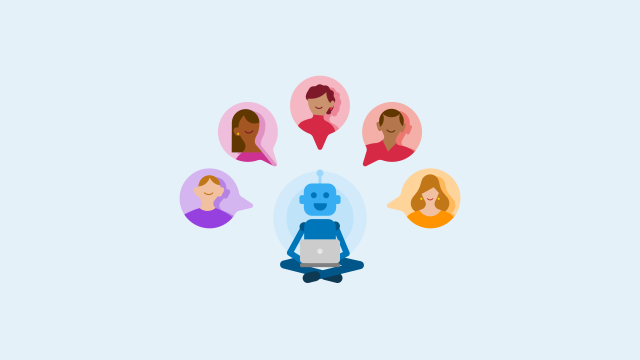In this article:
- Awkward conversations: Why customers don’t like chatbots
- Not understanding the customer: The main problems in human-bot-interaction
- Customers develop negative bias around chatbots
- What is conversation design?
- Chatbots for businesses: advantages of conversation design
- Success stories: How businesses are leveraging the advantages of conversation design
- Advantages of conversation design: Get the most out of it for your business
For businesses, chat interfaces, such as chatbots, are extremely useful. They can help customers 24/7, solve issues fast, and reduce the workload for employees. However, businesses that want to implement chatbots sometimes also face a big challenge: customers don’t particularly like chatbots. And that’s exactly the advantage of conversation design! It can tackle the issues behind awkward human-bot-interactions and turn them into engaging experiences.
From their very humble beginnings in the 1960s, chatbots since have come a long way to become useful tools for companies. Chatbots are commonly used in customer service to improve not only the day-to-day business, but also the relationship between business and consumer, and the customer’s experience. In practice, chatbots can help clients to buy products or services, can even help companies to gather data and generate leads. Overall, they can attend the clients’ needs faster, and reduce the workload for employees.
It's thus not surprising that nowadays more and more companies are willing to use and implement smart bots for their processes on a daily basis. The number of bots grew from 11,000 in 2016 to 300,000 in 2019. And of course, ChatGPT has taken this to the next level!
However, when thinking about implementing chatbots, companies face a huge challenge: customers usually don’t like them very much (but not why you think!). In the following, we'll look at some reasons behind this reluctance, and how conversation design can be the key to a successful human-bot-interaction.
Awkward conversations: Why customers don’t like chatbots
Many businesses assume that their customers don’t like chatbots because they prefer to interact with humans. However, research shows that most users are in fact quite open to bots. According to a study by customer support company Pidas, almost 89 percent of customers are interested in digital conversations with chatbots. Provided they are helpful.
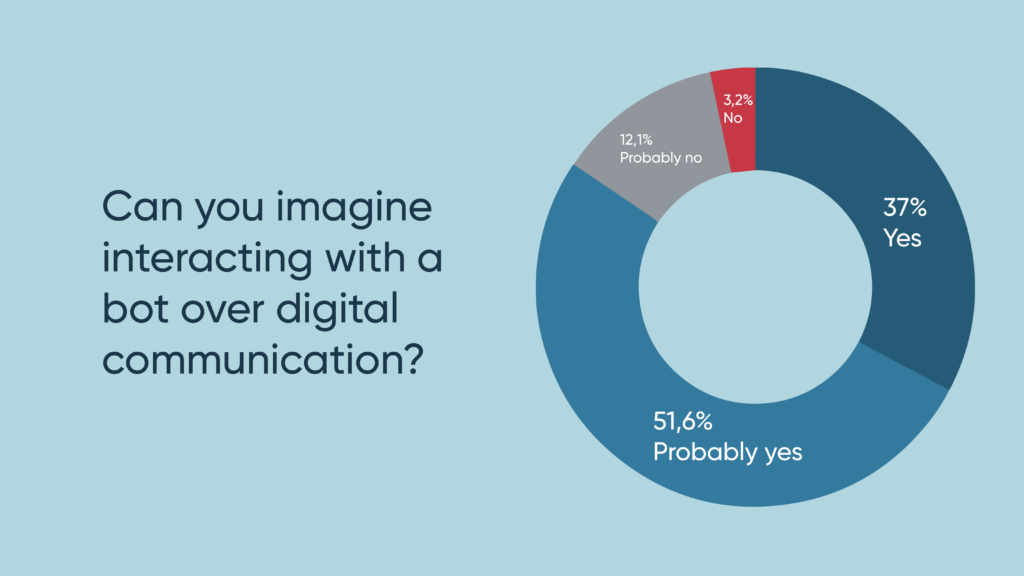
And that’s exactly where the problem lies! Many chatbots have been designed to solve specific tasks or to lead customers on a certain conversational path, but they haven't been designed to resemble an authentic human conversation. Therefore, the experiences that many customers have with chatbots could be sometimes awkward and even possibly unintelligible. So, in the end, instead of being helpful this could end up being a bad experience for clients.
Not understanding the customer: The main problems in human-bot-interaction
If chatbots don’t have the right tools to follow human conversations, they will also have a hard time understanding the customers’ requests.
The bot doesn't understand the customer
For example, if a chatbot is only designed to answer the question “Can you tell me more about the status of my delivery”, but a user asks, “Where is my package?”, it might take the bot a while to understand what the customer really wants. This is not only frustrating for the customer who didn’t get the help they needed, but also for the bot that wasn’t able to provide the proper answer.
Transferring customers to agents
Another issue in human-bot-interaction could be that a customer isn't transferred to a human agent at the right moment. If the re-routing happens too early, the employees end up having too much work. If it happens too late, customers might end up having a frustrating experience and feel that the bot didn’t help them.
Chatbots can help your team, but they can't replace employees
When talking about chatbots, many people’s assumption is that bots will replace humans. This could not be further from the truth. While bots are great in assisting employees, and reducing their workload, they cannot replace them. At the end, human-human-interaction is still needed and wanted. Therefore, it’s crucial for companies to figure out at what point customers are being referred to a human representative, and how that is communicated. Otherwise, the users might end up confused or even angry.
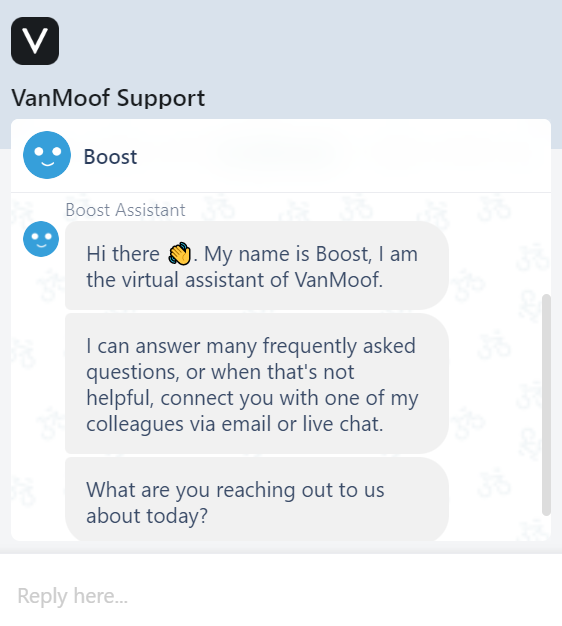
Customers develop negative bias around chatbots
After a few bad experiences, users start forming a negative bias against chatbots. A recent study from the Technical University of Darmstadt and the Copenhagen Business School has found that once users have had several negative chatbot interactions, they are less keen to talk and to comply with bots, to a point where they refuse to interact with them.
Luckily, there's a solution for businesses to avoid the negative human-bot-experience —conversation design.
What is conversation design?
Conversation design refers to designing the flow of conversation between a chatbot and a human user. It combines:
- Artificial intelligence (AI)
- Natural language processing (NLP)
- User experience design (UX), and
- Writing and linguistics
- Voice and motion
The idea of implementing conversational design into chatbots is to make the interaction between bot and human as natural and as smooth as possible. There are four key features that contribute to a successful conversation design.
1. Understanding
For a chatbot to have a successful conversation with a human, understanding is very important. However, understanding goes beyond simply knowing the meaning of a word or a sentence. It requires understanding their implications. In linguistics this is called pragmatics, and refers to the understanding of the social, cultural and situational context.
For instance, if one person tells another person of their household that they are out of milk, it is implied that someone will have to buy more milk. Consequently, a chatbot that uses conversational design, will also not simply say “It’s too bad that you are out of milk.”, but also add: “Would you like me to put it on your digital shopping list?”
2. Interaction
The more chatbots mirror human conversations, the higher their acceptance with users will be. To a certain extent, even if customers know they are talking to a bot, they expect a human-like presence on the other end. And this means: interacting!
After all, just like in a regular conversation with another person, nobody wants to listen to a long monologue. The same goes for talking to chatbots. If they just present customers with a long message and no interaction, it can be off-putting.
This means that conversation design must focus on the interactional aspect of the conversation between humans and bots, making it smooth and fluent.
3. Context
Understanding the context of the customer is another important aspect in conversation design. Chatbots need to understand where the user is coming from.
If somebody writes a message from a smartphone, the response might need to be shorter than if the user sends it from a desktop computer. The chatbot should also know that mobile users are possibly on the go and might not be able to access as much information as desktop users at home.
4. Natural language
Users respond better to chatbots if they act more like humans. This includes following the general norms of a conversation, such as saying “hello” or “goodbye” or introducing themselves with a name and using personal pronouns.
It is also critical for bots to show empathy, just like a human agent would. If, for example, a customer has technical issues, the chatbot should use phrases like “I am so sorry that you have problems, let me see how we can solve them as quickly as possible.” It'll make the conversation more natural, and the customer feels understood.
Chatbots for businesses: advantages of conversation design
The advantages of conversation designs are quite simple: the smoother the conversation between bot and human is, the better the customer experience.
Consequently, once you have been able to implement high-quality chatbots in your company, you'll also benefit more from them.
You'll be able to:
- …improve your brand’s image
- … reduce bounce rates
- … increase brand loyalty
- … drive conversions
Success stories: How businesses are leveraging the advantages of conversation design
Put into practice, conversation design will not only increase the efficiency of your company’s chatbots and help your employees to reduce their work load, it will also greatly increase customer satisfaction, as the following examples:
Bizbike: Making customers happy
As Belgium’s biggest e-bike provider Bizbike was looking for a way to keep customers satisfied by offering quick responses and high-quality support. In order to increase the efficiency of their customer service and reduce the workload for their employees, Bizbike implemented the conversation design chatbot from Sinch Chatlayer.
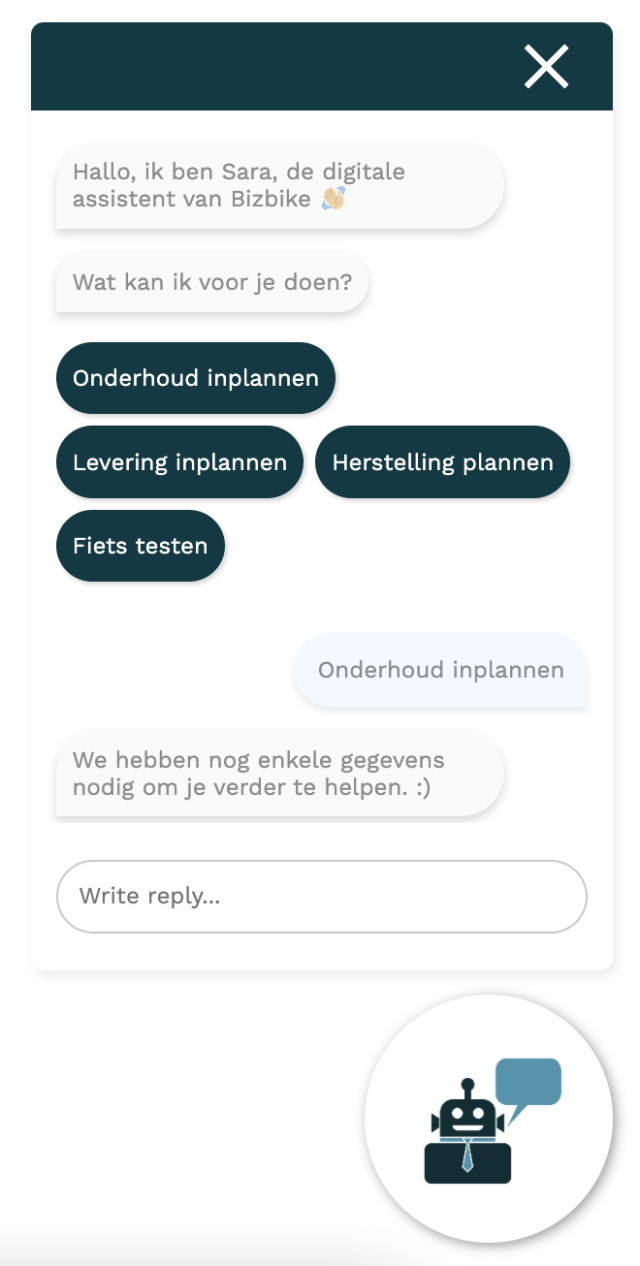
The automated answers were catered to the needs of Bizbike’s customers and made sure to have a smooth transfer between chatbot and agents. The solution was highly successful. Bizbike was able to save more than 40 hours per months through effective automation, and at the same time have an engaging conversation with their customers. Bizbike was able to increase their NPS score from 54 to 56, which means that 62 percent of their customers are actively promoting conversational chatbot solutions and the Bizbike service.
Since using the chatbots, we’ve seen an increase in NPS.
Helena Vandanbulck, Marketeer at Bizbike
European Commission: Helping thousands of travelers
Discover EU is an initiative led by the European Commission that helps 18-year-old EU citizens discover Europe by train. As many of these young Europeans are first-time travelers, they naturally find themselves in many situations where they require help on their trips.
After launching the initiative, frequent questions, such as: “What do I do if I missed my train?” or “Where does my train leave from?” ultimately were becoming challenging to handle by the staff of support agents during traditional office hours and across different time zones. As a solution, Sinch Chatlayer developed a chatbot in order to answer the travelers’ most common questions, which ended up helping thousands of young European explorers on their journeys.
In the first month, the chatbot solved more than 700 questions, and handed over approximately 150 questions to a live support agent.
European Commision
iFood: Conversational chatbots for own employees
iFood is an online food ordering and delivery platform based in Brazil. With growing demand and an increasing number of deliveries, the drivers’ customer service at iFood started facing new challenges. They were receiving more calls from drivers who needed assistance during their deliveries. Trying to help the drivers in a timely manner became more difficult, more time-consuming, more expensive, and came at the cost of driver satisfaction.
In order to not only improve the customer service for their drivers, but also the sales and customer service for their end users, iFood implemented a Conversational AI chatbot on its most relevant channels, such as WhatsApp and the website. The chatbot was able to register new drivers and help with the onboarding of new delivery staff.
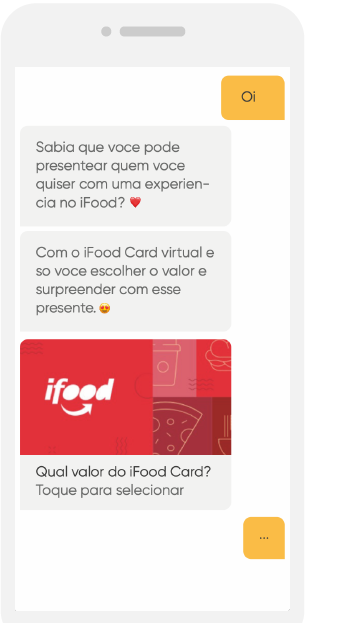
The AI solution also helped with the gift card service, completed consumer surveys, and measure NPS scores.
As a conversational AI chatbot, the bot was not only able to solve technical and logistical issues, but it also received a high satisfaction score of 91 percent from delivery drivers.
Advantages of conversation design: Get the most out of it for your business
Before you start building a chatbot for your company, there are a few things you should consider first.
- Know your customers, so you can tailor the conversational design around them.
- Think about the persona you want to develop for your bot. It should not only be built around the customer, but also represent your brand.
- Determine what you want to achieve with your bot. Should it answer FAQs, direct customers towards the right department, or solve complex problems?
- At what point do you want the bot to transfer customers to human agents? This process has to be smooth and also help your team.
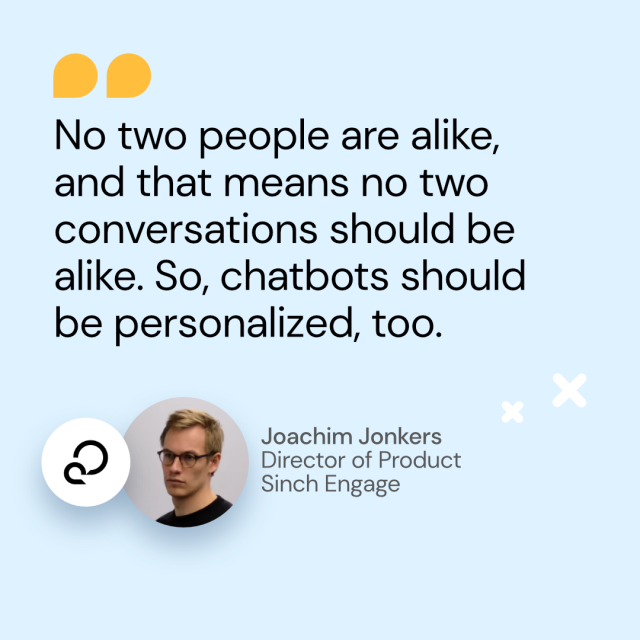
So, determining what the “right” chatbot is for your business really depends on your goals and your customers. This is where the flexible Chatlayer chatbot solution from Sinch Engage comes in!
It allows you to easily expand your chatbot capacities with a Conversational AI-based chatbot for all your channels that exactly suits your needs. You decide if you want to use pre-built templates or get a customized solution. You also pick the channels that make the most sense for you. With Sinch Engage, you can add messaging apps (including GPT integration!), voice, web chat, and many more to meet your customers exactly where they are!
Combining AI with the advantages of conversation design, allows you to have an even higher personalization in your dialogues, and more natural conversations.
💡Ready to improve your chatbot? Just schedule a customized consultation with our experts! The team will demonstrate the product, give you expert advice, and answer all your questions.
